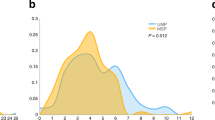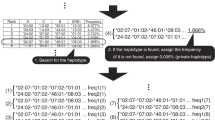Abstract
A simple scoring system that can provide a quick search prognosis at the onset of an adult unrelated donor (URD) search could be a useful tool for transplant physicians. We aimed to determine whether patient human leukocyte Ag genotype frequency (GF) could be used as a surrogate measure of whether or not a potential 10/10 and/or 9/10 URD in the Be The Match Registry (BTMR) can be identified for the patient. GF was assigned on a training data set of 2410 patients that searched the BTMR using the reported ethnic group. A proportional odds model was used to correlate GF with defined search productivity categories as follows: ‘Good’ (>2 10/10), ‘Fair’ (1–2 10/10 or No 10/10 and >2 9/10) or ‘Poor’ (No 10/10 and <3 9/10). A second cohort (n=2411) was used to calculate the concordance by the ethnic group in all three categories. In addition, we validated against an independent cohort (n=1344) resolved as having a 10/10 or 9/10 matched URD. Across the ethnic groups, >90% of cases with ‘Good’ GF prognosis, 20–26% ‘Fair’ and <10% ‘Poor’ had a 10/10 URD. Although not a replacement for an actual URD search, GF offers a quick way for transplant physicians to get an indication of the likely search outcome.
This is a preview of subscription content, access via your institution
Access options



Similar content being viewed by others
References
Petersdorf EW . The World Marrow Donor Association: 20 years of international collaboration for the support of unrelated donor and cord blood hematopoietic cell transplantation. Bone Marrow Transplant 2010; 45: 807–810.
Lee SJ, Klein J, Haagenson M, Baxter-Lowe LA, Confer DL, Eapen M et al. High-resolution donor-recipient HLA matching contributes to the success of unrelated donor marrow transplantation. Blood 2007; 110: 4576–4583.
Flomenberg N, Baxter-Lowe LA, Confer D, Fernandez-Vina M, Filipovich A, Horowitz M et al. Impact of HLA class I and class II high-resolution matching on outcomes of unrelated donor bone marrow transplantation: HLA-C mismatching is associated with a strong adverse effect on transplantation outcome. Blood 2004; 104: 1923–1930.
Woolfrey A, Klein JP, Haagenson M, Spellman S, Petersdorf E, Oudshoorn M et al. HLA-C antigen mismatch is associated with worse outcome in unrelated donor peripheral blood stem cell transplantation. Biol Blood Marrow Transplant 2011; 17: 885–892.
Horan J, Wang T, Haagenson M, Spellman SR, Dehn J, Eapen M et al. Evaluation of HLA matching in unrelated hematopoietic stem cell transplantation for nonmalignant disorders. Blood 2012; 120: 2918–2924.
Fernandez-Vina MA, Klein JP, Haagenson M, Spellman SR, Anasetti C, Noreen H et al. Multiple mismatches at the low expression HLA loci DP, DQ, and DRB3/4/5 associate with adverse outcomes in hematopoietic stem cell transplantation. Blood 2013; 121: 4603–4610.
Pidala J, Lee SJ, Ahn KW, Spellman S, Wang HL, Aljurf M et al. Nonpermissive HLA-DPB1 mismatch increases mortality after myeloablative unrelated allogeneic hematopoietic cell transplantation. Blood 2014; 124: 2596–2606.
Burt C, Parker A, McQuaker G, Copland M, Brierley C, Little AM et al. In a 12-allele analysis HLA-DPB1 matching is associated with improved OS in leukaemic and myelodysplastic patients receiving myeloablative T-cell-depleted PBSCT from unrelated donors. Bone Marrow Transplant 2014; 49: 657–663.
Fleischhauer K, Shaw BE, Gooley T, Malkki M, Bardy P, Bignon JD et al. Effect of T-cell-epitope matching at HLA-DPB1 in recipients of unrelated-donor haemopoietic-cell transplantation: a retrospective study. Lancet Oncol 2012; 13: 366–374.
Aversa F, Tabilio A, Velardi A, Terenzi A, Falzetti F, Carotti A et al. Hematopoietic stem cell transplantation from alternative donors for high-risk acute leukemia: the haploidentical option. Curr Stem Cell Res Ther 2007; 2: 105–112.
Anasetti C, Aversa F, Brunstein CG . Back to the future: mismatched unrelated donor, haploidentical related donor, or unrelated umbilical cord blood transplantation? Biol Blood Marrow Transplant 2012; 18 (Suppl 1): S161–S165.
Fuchs EJ . HLA-haploidentical blood or marrow transplantation with high-dose, post-transplantation cyclophosphamide. Bone Marrow Transplant 2015; 50 (Suppl 2): S31–S36.
Pedron B, Duval M, Elbou OM, Moskwa M, Jambou M, Vilmer E et al. Common genomic HLA haplotypes contributing to successful donor search in unrelated hematopoietic transplantation. Bone Marrow Transplant 2003; 31: 423–427.
Pedron B, Guerin-El Khourouj V, Dalle JH, Ouachee-Chardin M, Yakouben K, Corroyez F et al. Contribution of HLA-A/B/C/DRB1/DQB1 common haplotypes to donor search outcome in unrelated hematopoietic stem cell transplantation. Biol Blood Marrow Transplant 2011; 17: 1612–1618.
Joris MM, Lankester AC, von dem Borne PA, Kuball J, Bierings M, Cornelissen JJ et al. The impact of frequent HLA haplotypes in high linkage disequilibrium on donor search and clinical outcome after unrelated haematopoietic SCT. Bone Marrow Transplant 2013; 48: 483–490.
Tiercy JM, Nicoloso G, Passweg J, Schanz U, Seger R, Chalandon Y et al. The probability of identifying a 10/10 HLA allele-matched unrelated donor is highly predictable. Bone Marrow Transplant 2007; 40: 515–522.
Hirv K, Bloch K, Fischer M, Einsiedler B, Schrezenmeier H, Mytilineos J . Prediction of duration and success rate of unrelated hematopoietic stem cell donor searches based on the patient's HLA-DRB1 allele and DRB1-DQB1 haplotype frequencies. Bone Marrow Transplant 2009; 44: 433–440.
Gourraud PA, Balere ML, Faucher C, Loiseau P, Dormoy A, Marry E et al. HLA phenotypes of candidates for HSCT: comparing transplanted versus non-transplanted candidates, resulting in the predictive estimation of the probability to find a 10/10 HLA matched donor. Tissue Antigens 2014; 83: 17–26.
Pidala J, Kim J, Schell M, Lee SJ, Hillgruber R, Nye V et al. Race/ethnicity affects the probability of finding an HLA-A, -B, -C and -DRB1 allele-matched unrelated donor and likelihood of subsequent transplant utilization. Bone Marrow Transplant 2013; 48: 346–350.
Gragert L, Madbouly A, Freeman J, Maiers M . Six-locus high resolution HLA haplotype frequencies derived from mixed-resolution DNA typing for the entire US donor registry. Hum Immunol 2013; 74: 1313–1320.
Maiers M, Gragert L, Klitz W . High-resolution HLA alleles and haplotypes in the United States population. Hum Immunol 2007; 68: 779–788.
Spellman SR, Eapen M, Logan BR, Mueller C, Rubinstein P, Setterholm MI et al. A perspective on the selection of unrelated donors and cord blood units for transplantation. Blood 2012; 120: 259–265.
Agresti A . Categorical Data Analysis 3rd edn. Wiley: Hoboken, NJ, USA, 2013.
Dehn J, Buck K, Maiers M, Confer D, Hartzman R, Kollman C et al. 8/8 and 10/10 high-resolution match rate for the be the match unrelated donor registry. Biol Blood Marrow Transplant 2015; 21: 137–141.
Buck K, Wadsworth K, Setterholm M, Maiers M, Confer D, Hartzman R et al. High-Resolution Match Rate of 7/8 and 9/10 or Better for the Be The Match Unrelated Donor Registry. Biol Blood Marrow Transplant 2016; 22: 759–763.
Acknowledgements
This research was funded by the Office of Naval Research grant N00014-14-1-0028. The views expressed in this article are those of the author and do not necessarily reflect the official policy or position of the Department of the Navy, Department of Defense, nor the US Government.
Author information
Authors and Affiliations
Corresponding author
Ethics declarations
Competing interests
The authors declare no conflict of interest.
Rights and permissions
About this article
Cite this article
Wadsworth, K., Albrecht, M., Fonstad, R. et al. Unrelated donor search prognostic score to support early HLA consultation and clinical decisions. Bone Marrow Transplant 51, 1476–1481 (2016). https://doi.org/10.1038/bmt.2016.162
Received:
Revised:
Accepted:
Published:
Issue Date:
DOI: https://doi.org/10.1038/bmt.2016.162



